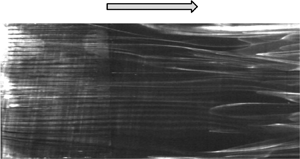Article contents
Skin-friction reduction using periodic blowing through streamwise slits
Published online by Cambridge University Press: 16 June 2021
Abstract

Active skin-friction reduction in a turbulent boundary layer (TBL) is experimentally studied based on time-periodic blowing through one array of streamwise slits. The control parameters investigated include the blowing amplitude A+ and frequency f+, which, expressed in wall units, range from 0 to 2 and from 0.007 to 0.56, respectively. The maximum local friction reduction downstream of the slits reaches more than 70 %; friction does not fully recover to the state of the natural TBL until 500 wall units behind the slits. A positive net power saving is possible, and 4.01 % is measured with a local friction drag reduction (DR) of 49 %. A detailed analysis based on hot-wire, particle image velocimetry and smoke-wire flow visualization data is performed to understand the physical mechanisms involved. Spectral analysis indicates weakened near-wall large-scale structures. Flow visualizations show stabilized streaky structures and a locally relaminarized flow. Two factors are identified to contribute to the DR. Firstly, the jets from the slits create streamwise vortices in the near-wall region, preventing the formation of near-wall streaks and interrupting the turbulence generation cycle. Secondly, the zero-streamwise-momentum fluid associated with the jets also accounts for the DR. A closed-loop opposing control system is developed, along with an open-loop desynchronized control scheme, to quantify the two contributions. The latter is found to account for 77 % of the DR, whereas the former is responsible for 23 %. An empirical scaling of the DR is also proposed, which provides valuable insight into the TBL control physics.
JFM classification
- Type
- JFM Papers
- Information
- Copyright
- © The Author(s), 2021. Published by Cambridge University Press
Footnotes
Joint first authors.
References
- 17
- Cited by





